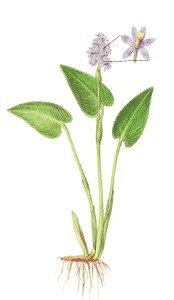Pickerelweed Facts Basic Information
Pickerelweed (Pontederia cordata) also called pickerel weed, tuckahoe, black potato, wampee or wampi is an aquaticplant native to the Americas (both North and South). It is perennial plant that can grow from either seeds or rhizomes. Pickerelweed forms large colonies along shallow shorelines, usually growing from its spreading rhizomes. The seed of the plant needs a period of cold dormancy, called stratification, for about 2 months before it will sprout a seedling. In temperate zones the growth dies back in late fall only to emerge again in Spring when weather is favorable.
Pickerelweed is important for wildlife. Deer are fond of it, as are muskrats and ducks. It also has its own bee for pollination!!
Description
As named, pickerel weed is an aquatic plant. It is a rather large plant,
reaching up to 4 feet tall. The leaves and stems of the plant are green and somewhat waxy in appearance. They develop at the ends  of stems and are highly variable in shape and size. Leaf shape ranges from an oval to almost lance shaped. Leaf sizes are also variable, ranging from as small as 2 inches to as much as 10 inches long and from less than an inch up-to 6 inches wide. Leaf veins run parallel in the leaf and are never “net-like”.
of stems and are highly variable in shape and size. Leaf shape ranges from an oval to almost lance shaped. Leaf sizes are also variable, ranging from as small as 2 inches to as much as 10 inches long and from less than an inch up-to 6 inches wide. Leaf veins run parallel in the leaf and are never “net-like”.
The small flowers are violet-blue in color and bloom in summer. They are small and cluster around a stalk-like stem (see picture). The flowers are the key to really identifying the plant.
Habitat
Just like water lily, pickerelweed grows in a variety of wetlands including pond and lake margins and the edge of a slow moving streams. It prefers shallow water, a foot or so deep. Pickerelweed does not do well in salt water, so you will never find pickerelweed growing in salt marshes.
Range
Pickerelweed has an extremely large range, its northern most
reach is eastern Canada as far north as Nova Scotia, west to Minnesota and south to Florida and Texas. It is found as far south as Argentina in South America.
Edible
The seeds are edible, when dried, roasted and ground they make a good flour for bread. They can also be eaten raw, cooked even boiled like rice or roasted like nuts. Young unfurled leaves can be eaten raw or boiled and eaten. Stalks are edible as well and are prepared just like leaves. Please make sure the water you take the plant from is clean and unpolluted.